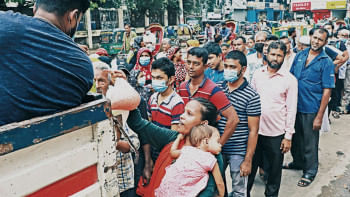Youth involvement must to solve water-related challenges
Water experts at Stockholm World Water Week have urged youths to become more involved and solve water related challenges.
CEO of a leading water technology company, Xylem, Patrick Decker said to the youth, “Don't make the same mistake my generation made. You are the people who can secure water for future.”
“Please seriously consider water in your thought process. Be passionate about water,” said Decker, whose initiative is among the Fortune 50 companies that impacted social change.
Leading water research institution Stockholm International Water Institute (SIWI) Chairman Peter Forssman also stressed on the importance of youth involvement at the prize giving ceremony of the World Water Week at Stockholm.
He said there is an immediate need of new ideas to meet the future.
Crown Princess of Sweden, Victoria Ingrid Alice Désirée, presented the award on Tuesday to the winner of Stockholm Junior Water Prize, which recognises the work of young people interested in water and environmental issues.
Two students from Singapore, Caleb Liow Jia Le and Johnny Xiao Hong Yu, won the 2018 Stockholm Junior Water Prize for producing reduced graphene oxide, a material that can be used to purify water, from agricultural waste.
After receiving the prize, Caleb told The Daily Star, “I'm elated that we won the prize, because I really didn't expect it. All the projects were brilliant.”
The Stockholm Junior Water Prize goes to the winners of an international annual competition with more than 10,000 entries from all over the world. Princess Victoria is the patron of the prize.
In its citation, the jury highlighted the wide local benefits of the students' method, “This year's winning project inspires communities to find local solutions to improve water quality and resource recovery.”
Torgny Holmgren, executive director of SIWI, said, “Provision of clean water is one of humanity's greatest challenges. This year's outstanding winners have found a way to purify water that is low-cost, builds on locally available resources and can help getting clean water to the 2.1 billion people who still lack it.”
As part of the Stockholm Junior Water Prize final, a Diploma of Excellence was awarded to Tatsuyoshi Odai and Narumi Sakamoto, two students from Japan.
The competition brings together young people -- between the ages of 15 and 20 -- who have conducted water-related projects of proven environmental, scientific, social or technological significance.
This year, 48 national finalists from 32 countries competed in the international final held during World Water Week in Stockholm.
One Bangladeshi student named Didarul Islam was the finalist with his project of combating water contamination using plastic waste.
PEOPLE STILL VULNERABLE TO ARSENIC POISONING
The top global water meet in the world heard on Tuesday that people in Bangladesh were still exposed to arsenic contamination. Speakers said a significant number of people were still vulnerable to arsenic poisoning because of their lack of access to clean water.
Speakers also agreed that since the arsenic problem could not be eradicated, its mitigation requires coordinated efforts.
Bangladesh government has taken up a project to screen and gradually alleviate arsenic exposure. The government aims to eliminate 60 percent of the existing arsenic contamination within four years.
The Tk 1,990 crore project will be implemented at 1,290 unions of 117 upazilas under 31 districts to mitigate arsenic contamination in affected areas or where people are at risk.
The whole country will be screened for arsenic contamination under this project, said Tushar Mohon Khan, superintending public health engineer, at a discussion on sediment colour tool and empowering local drillers for safe water.
Safe water coverage in Bangladesh was around 97 percent in the early 1990s, but dropped to 74 percent with the detection of arsenic contamination.
“Safe water coverage is up at 88 percent due to government intervention. It will further rise to 96 percent once the project has been fully implemented,” said the senior official of public health engineering department (DPHE).
Meanwhile, Unicef has taken up a project to develop arsenic-safe villages in 20 unions of Bangladesh.
“We have already announced 233 villages arsenic-free. Now we aim to announce entire unions as arsenic-safe,” said Nargis Akhter, water sanitation and hygiene officer of the UN children's agency in Bangladesh.
The Unicef official from Bangladesh said the problem with arsenic was that although it is a serious issue, there were no coordinated efforts to mitigate it. “Besides, there are technical challenges as well,” she said.
She also observed that progress had been unsatisfactory on this front despite expenditure of substantial funds.
According to Nargis Akhter, the challenges included the absence of specific time-bound targets for the government and development agencies. She said there was a lack of awareness and no harmonised approach, adding that inadequate knowledge of local geology also led to the installation of wells in unsafe aquifers.
Bruce Gordon, coordinator of water, sanitation, hygiene and health of WHO, said the risk of arsenic contamination was not limited to Bangladesh. It is rather a global problem.
But, he said, Bangladeshis had local knowledge in this regard which was fascinating.

 For all latest news, follow The Daily Star's Google News channel.
For all latest news, follow The Daily Star's Google News channel. 



Comments